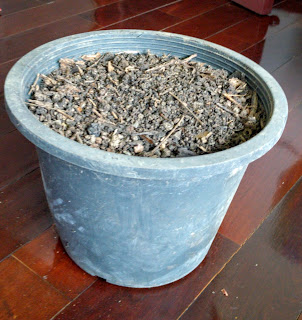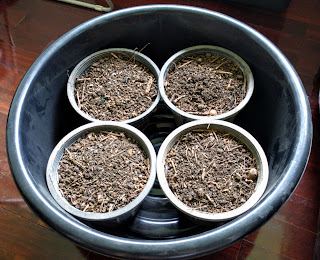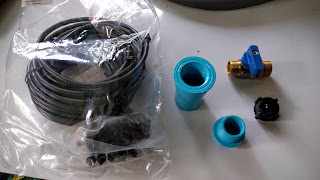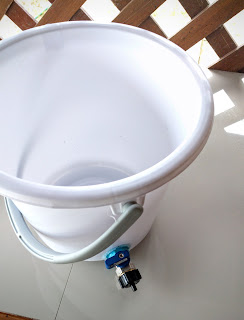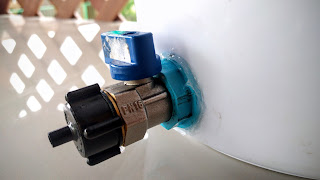I’ve been thinking about growing food plants indoors for about a month now. I’m not sure whether it is worth the effort, but I’m experimenting with it to see.
I’m less interested in hydroponics as I’ve read that it can cause an unusually high level of certain chemicals in your food. And what’s wrong with growing plants in soil anyway?
I figured I would start with lettuce because it is pretty easy to grow and I eat salads a couple times per week…
So I’m starting with pots of soil placed inside a plastic tub…
The tub will collect any excess water that drips out the bottom of the plant pots.
For watering, I’m hoping to use a constant drip flow from a bucket that I can refill once or twice per week. I always like having systems that maintain themselves over the course of a number of days, if only for the fun of building them. So I bought a valve and some attachments and HDPE watering tube at HomePro.
And mounted it into the side of a bucket:
And the ring where the PVC presses against the side of the bucket is sealed on both sides with silicone sealant so it doesn’t drip.
Hopefully, I can find a position of the valve that will allow the water to drip down at a slow enough rate that I can just leave it in one position all the time to keep the soil moist without soaking it.
The last step will be to mount up some LED lights similar to the ones we are using to light the house as growth lights. From what I’ve read, these need to be timed to give the plants both light and dark periods. So I will use a microcontroller to turn the LEDs on and off for a given number of hours per day. But in terms of the amount of light required to grow lettuce, I’m going to start with about 5 watts of LEDs as a first try and maybe do some calculations afterwards. I’m really curious to see the results from my first test, and I’ll try to explain why it had whatever problems it had later. (This is my normal strategy. Do a first test, then learn about the results. It is a lot easier to learn after you’ve done something rather than trying to imagine everything beforehand.)
So why grow plants indoors with artificial lighting when sunlight is free? I can think of a few reasons:
- We’ve had a lot of problems with insects eating our plants outdoors. Lettuce in particular is yummy for caterpillars and snails. This should be easier to prevent in a more controlled indoor environment.
- We can control the amount of water. The rainy season in Thailand has so much water that it can soak a plant bed and promote mold. I haven’t experimented with a glass roof to reduce rain water, but care must be taken not to get a greenhouse type heat effect because it is already too hot here for many plants.
- We can easily control the amount of light.
- We tend to cook shortly after sunset, and we tend to harvest plants from the garden when we cook. But the mosquitoes here are most active right around then. So this is usually a time we don’t want to go outside into a garden and get molested by a swarm of ravenous blood suckers.
- If you are living in an apartment, you may not have any gardening space. This one doesn’t apply to us, as we have plenty of gardening space. But it may apply to others.
Why not grow plants indoors? The only two reasons I can think of are:
- Waste of electricity to power the lights
- Watering indoors may result in increased humidity
While the humidity issue is easy enough to deal with by simply keeping it in a bathroom, experimenting with the electricity usage is actually one of the reasons I want to try it. How much electricity does it actually use? Now that we know how to easily source high power LED lights, does the improved efficiency of LEDs result in substantially less electricity required? If my small garden of what might be 12 heads of lettuce can operate on 5W of LEDs on for 12 hours per day, then this will come out to about 60Wh per day. (My watering system uses zero electricity, and doesn’t even need water from the utility main since we collect plenty of rain water that I can carry inside once a week to fill up the dripper bucket.) For comparison, if you have a 1500W air conditioner, this is the equivalent of 2.4 minutes of air conditioning per day. Or about 3% of the electricity that an average refrigerator uses per day. (Based on this site.) This is also about 3% of the electricity that just one of our solar panels produces per day (on a sunny day).
So the electricity usage might be almost negligible. But I’ll have to try it to actually see if 5W of LEDs is enough.
And the last reason I’m interested in growing indoors is to experiment with cold climate crops. In particular berries. I do enjoy living primarily off of local fruits and vegetables. But blueberries, strawberries, and other cold climate crops are an enjoyable occasional treat. They are usually imported from other countries (like New Zealand, Australia, and the good ol’ USA). And they cost a lot. Easily 300-400THB for 100g (about $10 for 0.2 lbs). And they tend to taste pretty bad. I’m pretty sure this is because they pick them unripe so they don’t rot on the trip over. (Except the blueberries, which actually taste pretty good. So in general, if I am going to splurge, I’ll buy a small pack of blueberries that can last me for a few days if I sprinkle it over my yogurt. Yogurt with passion fruit, banana, papaya and just a small amount of blueberries and a bit of granola for crunch is a really good way to start the day. A few days per year.)
So I’ve read of people using refrigerated water for watering indoor plants to trick plants like strawberries into flowering in tropical weather. If I can come up with a system than can produce 1-2kg of berries for less than $100 per year in refrigeration costs, then I am coming out ahead. And since I can pick the berries ripe, they won’t taste like cardboard like the ones from the supermarket.
Anyway, I’m getting ahead of myself. I’m starting out with lettuce. 🙂

